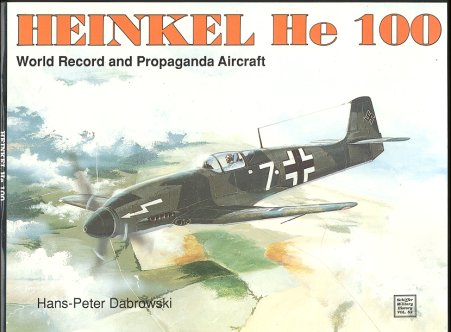|
BOOK: |
Heinkel He-100:
World Record and Propaganda Aircraft |
|
BY: |
Hans-Peter Dabrowski |
|
PUBLISHER
/PRICE: |
Schiffer
$9.95 |
|
REVIEW BY: |
Scott
Van Aken |
|
NOTES: |
|
 Heinkel's He-100 is a relatively unknown
aircraft, despite the fact that it twice held the worlds absolute speed record.
The airplane was a private venture by Ernst Heinkel to capture the air speed
record and to hopefully have a fighter that the Luftwaffe would consider
buying.
Heinkel's He-100 is a relatively unknown
aircraft, despite the fact that it twice held the worlds absolute speed record.
The airplane was a private venture by Ernst Heinkel to capture the air speed
record and to hopefully have a fighter that the Luftwaffe would consider
buying.
Like Messerschmitt's
Me-209v1, the He-100 record aircraft was built strictly for the speed record
however, it was much closer to a production-type aircraft than the diminutive
and treacherous Me-209v1. After a short see-saw battle with the -209, Heinkel
was told to stop and let Messerschmitt have the record. Most of the prototype
aircraft were later sold to the Russians and a few to Japan as well where they
were used to study aeronautical advancements. The author suggests that much of
the He-100 was copied by these two countries and used in upcoming aircraft,
however I find that to be a bit of a stretch.
The author states
that a total of 23 aircraft were produced, including the prototypes. Those that
were not sold were used as part of the Heinkel factory protection flight and as
test aircraft. However, the greatest use was as a 'propaganda' figher.
Those few built to
production standards were painted in various unit markings and photographed
extensively. These photos were then published in German aviation magazines, all
touting the new He-113, an aircraft that did not exist as such. So successful
was the campaign that many British fighter pilots reported not only seeing the
aircraft in combat, but also claiming a number of them as victories. To all
knowledge, the He-100 was neither a victor or victim in any aerial combat.
Now on to the book
itself. It is in the 'in Action' format, but without any profile paintings. Most
of the photographs in the book have been seen by the reviewer in a number of
other publications, however, there were some that were new to me. Most of them
are well reproduced and clear.
The history section
as such is not that large and basically only covers the prototype aircraft. The
author gives a good accounting of the history of each prototype and its ultimate
fate. That is where the historical section stops. The rest of the book is
photographs. As a note, the font used in the historical section is quite small
and would benefit from being larger. Considering that there is some 'white
space' in the book, it would be a great help to have larger type.
If you have an
interest in the type and no other references, then I can highly recommend this
book. There is much in it that is helpful not only to the historically
interested, but to the modeler as well.
Review sample courtesy of
Drew Nix. Thanks for the loan.
If you would like your product reviewed fairly and quickly by a
site that has over 1,500 visits a day, please contact
me or see other details in the Note to
Contributors.
 Heinkel's He-100 is a relatively unknown
aircraft, despite the fact that it twice held the worlds absolute speed record.
The airplane was a private venture by Ernst Heinkel to capture the air speed
record and to hopefully have a fighter that the Luftwaffe would consider
buying.
Heinkel's He-100 is a relatively unknown
aircraft, despite the fact that it twice held the worlds absolute speed record.
The airplane was a private venture by Ernst Heinkel to capture the air speed
record and to hopefully have a fighter that the Luftwaffe would consider
buying.